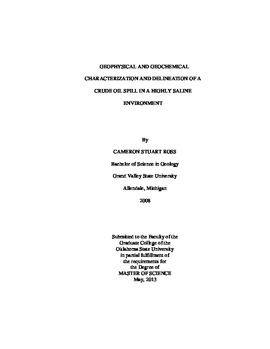| dc.contributor.advisor | Atekwana, Estella Akweseh | |
| dc.contributor.author | Ross, Cameron Stuart | |
| dc.date.accessioned | 2014-09-24T14:18:15Z | |
| dc.date.available | 2014-09-24T14:18:15Z | |
| dc.date.issued | 2013-05-01 | |
| dc.identifier.uri | https://hdl.handle.net/11244/11120 | |
| dc.description.abstract | Geophysical and geochemical methods were used at Grand Terre 1 (GT1) Island off the coast of Louisiana, an island that had been heavily contaminated with crude oil associated with the April 2010 BP Deepwater Horizon oil spill.Electrical methods and aqueous geochemistry have proven sensitive in the detection of contaminates, as well as the biological and chemical processes associated with the biodegradation of hydrocarbons in the subsurface. However, to the author's knowledge, all of these studies have dealt with mature (or aged) spills within a freshwater environment. The BP Deepwater Horizon oil spill therefor provided a unique opportunity to not only use traditional geophysical and geochemical methods to characterize and delineate fresh crude oil in a highly saline environment and to capture the early time biogeophysical signals resulting from the physical, chemical, and microbial transformation of crude oil in a highly saline environment.Electrical resistivity and electromagnetic methods were used. Barometric pressure, temperature, electrical conductivity, and water level values for the shallow groundwater were continuously logged. Geochemical analysis was performed on water samples collected from piezometers networks installed in the impacted, transitional, and background areas. Sediment cores were retrieved throughout the site and used for grain size analysis, magnetic susceptibility, total organic and inorganic carbon, and x-ray fluorescence. Soil samples were collected for microbial analyses from the impacted and background areas. Microcosms were set up to determine the microbial diversity analysis was used to determine microbial community composition, and biodegradation potential of indigenous populations.Based on the geochemical, microbial, and soil analysis, the relatively higher apparent resistivity anomaly observed between the depths of 0.20 m to 1.20 m bgs could be explained by two scenarios(1): elevated resistivity was caused by gas in the subsurface produced by the degradation of organic matter coupled to sulfate and iron reduction. (2): from variations in salinity. This research demonstrates the sensitivity of geophysical and geochemical methods commonly used to detect contaminates in freshwater environment can also be utilized in a saline, coastal environment. | |
| dc.format | application/pdf | |
| dc.language | en_US | |
| dc.publisher | Oklahoma State University | |
| dc.rights | Copyright is held by the author who has granted the Oklahoma State University Library the non-exclusive right to share this material in its institutional repository. Contact Digital Library Services at lib-dls@okstate.edu or 405-744-9161 for the permission policy on the use, reproduction or distribution of this material. | |
| dc.title | Geophysical and Geochemical Characterization and Delineation of a Crude Oil Spill in a Highly Saline Environment | |
| dc.type | text | |
| dc.contributor.committeeMember | Atekwana, Eliot Anong | |
| dc.contributor.committeeMember | Halihan, Todd | |
| osu.filename | Ross_okstate_0664M_12717.pdf | |
| osu.accesstype | Open Access | |
| dc.description.department | Geology | |
| dc.type.genre | Thesis | |
